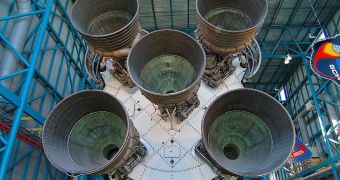Officials at the American space agency announce that it has recently selected 13 corporations to conduct negotiations with for the potential awarding of contracts concerning the creation of trade studies and system analysis for prospective heavy-lift launch vehicle system concepts.
Under the new NASA Authorization Bill that passed Congress at the end of October, the space agency needs to start work on developing a new type of large rocket as soon as possible.
President Barack Obama's initial proposal called for this process to be spread out over the next 3 to 5 years, but Congress was unwilling to wait for so long, so efforts were urged closer.
In addition to the concept designs themselves, the agency is also interested in developing blueprints for more advanced propulsion technologies, and also in obtaining notices on the costs of these systems.
The companies it selected for the job include Rancho Cordova, California-based Aerojet General Corp., Analytical Mechanics Associates, in Huntsville, Ala., and Andrews Space, in Tukwila, Washington.
Some major players from the space industry can also be found on the list, such as Alliant Techsystems, Boeing, Lockheed Martin, Orbital Science Corp., Northrop Grumman, and Pratt & Whitney Rocketdyne.
The United Launch Alliance, the United Space Alliance, the Space Exploration Technologies Corp., and the Science Applications International Corporation end the list of companies NASA wants to talk to.
“These trade studies will provide a look at innovative launch vehicle concepts, propulsion technologies, and processes that should make human exploration missions more affordable,” explains Doug Cooke.
The official holds an appointment as an associate administrator at the Exploration Systems Mission Directorate, which is based at the NASA Headquarters, in Washington DC.
“If we are to travel beyond low-Earth orbit, industry's collaboration is essential to reduce the cost associated with our future exploration goals and approaches and make the heavy-lift vehicle affordable to build and fly,” he adds.
The official explains that the new awards total about $7.5 million, while the largest of them amounts to $625,000. The new spacecraft designs need to be able to launch to humans to asteroids, Lagrange points, the Moon and Mars, NASA says.
In order for the American space program to become sustainable, NASA needs to search for more feasible solutions in designing its spacecrafts. Costs need to be brought down considerably, and innovations are required in order for that to happen.

 14 DAY TRIAL //
14 DAY TRIAL //